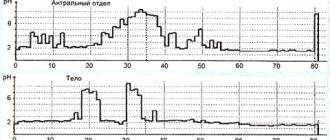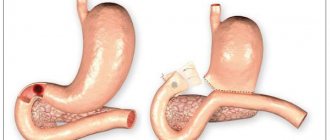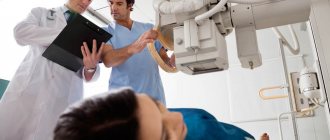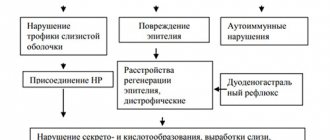- Gastritis of various etiologies
- Gastroesophageal reflux disease (GERD)
- Duodenitis
- Chronic Helicobacter gastritis
- Peptic ulcer of the stomach and duodenum
Symptoms Classification Diagnostics Treatment Information
Pathologies of the esophagus, stomach and duodenum play a leading role in diseases of the gastrointestinal tract. This directly affects the quality of life of patients.
Disturbances in the functioning of the esophagus are associated mainly with failures of its motor function. Pathologies of the stomach, esophagus, and duodenum are most often caused by the activity of bacteria (Helicobacter pylori), inflammatory processes, congenital characteristics of the body, and neoplasms.
THE INSTITUTE OF ALLERGOLOGY AND CLINICAL IMMUNOLOGY has:
- range of services for accurate diagnosis of diseases
- special treatment programs
- consultations are carried out by doctors with academic degrees.
When identifying concomitant diseases, consultations are held with specialists in related fields (otorhinolaryngologists, endocrinologists, neurologists, gastroenterologists, dermatovenerologists), consultations with Doctors of Medical Sciences.
Attention!
Helicobacter pylori is a causative agent of cancer in the gastrointestinal tract.
Symptoms
Diseases of the esophagus are characterized by the following symptoms:
- chest pain,
- difficulty swallowing,
- heartburn,
- nausea,
- belching.
Often the clinical picture is similar to manifestations of pathologies of other systems - respiratory, cardiovascular (dry cough, difficulty breathing, chest pain, shortness of breath).
If these symptoms occur, you should consult a gastroenterologist-hepatologist!
For chronic diseases of the stomach and duodenum, characteristic symptoms will be pain in the epigastric region (epigastric region). As a rule, they are associated with food intake. Stomach pathologies are characterized by the appearance of pain 15-20 minutes after eating. They last for several hours and may go away on their own. In diseases of the duodenum, pain begins 1.5-2 hours after eating.
With the development of tumors, pain is expressed in different ways: it can be associated or not associated with food. The development of malignant tumors of the stomach is characterized by pain not related to food (“hunger” pain, pain at night). Appetite is lost and significant weight loss occurs. An aversion to previously favorite foods appears. Sometimes - belching of undigested food.
“Stomach problems can happen even due to stress”: an interview with a gastroenterologist
Diseases of the gastrointestinal tract are among the most common compared to pathologies of other organs. According to Rospotrebnadzor, in Russia, more than 50–60% of people suffer from digestive system disorders among the adult population alone, and in large cities this figure reaches 95%. What are the symptoms of such diseases, how often do you need to be examined, what treatment methods exist today and how to prevent the disease.
Marina Smirnova, a gastroenterologist and head of the clinic at the Russian-Finnish Medical Center Terve, answered these questions.
How often are gastrointestinal problems treated?
The gastrointestinal tract (GIT) or digestive system is one of the largest systems in our body, starting in the mouth and ending in the rectum. Here everything we eat is processed, digested, absorbed and excreted, and since it is not always possible to eat correctly, everyone has experienced some unpleasant symptoms (heartburn, pain), and diseases of the gastrointestinal tract are the most common throughout the world.
Other organs and systems depend on the functioning of the gastrointestinal tract, including the immune system, since some of the cells of the immune system are located in the intestines, as well as the nervous and endocrine systems. Skin problems, and most of the oncological diseases also occur in the gastrointestinal tract. Therefore, there are always enough calls for gastrointestinal problems.
When should you go to a gastroenterologist?
You should think about visiting a doctor if some unpleasant symptom associated with digestion bothers you regularly, 1-2 times a week and for a long time, especially if you feel heaviness, pain, heartburn, bloating, problems with stool, etc. every day. etc. And definitely go to the doctor if you have night pain, weight loss, loss of appetite, vomiting, diarrhea, blood in the stool.
Now, amid the pandemic, most people who have suffered from coronavirus have taken a large number of medications, including antibacterial ones, have problems with the intestines and liver, and this requires mandatory consultation with a doctor, plus the number of so-called “anxious” patients has increased , in whom, due to constant stress and anxiety, all symptoms intensify, diseases become aggravated, which requires mandatory examination and treatment.
What methods of examining the gastrointestinal tract are there today?
A comprehensive examination plan includes instrumental methods - endoscopy (EGD), colonoscopy, ultrasound, duodenal intubation, and various laboratory tests - blood tests, stool tests and others. Moreover, a person who makes an appointment with a gastroenterologist is warned that it is best to come prepared, that is, on an empty stomach, then he can undergo almost all the necessary procedures in one day - ultrasound, FGS, take a blood test, if required according to indications. Based on the examination results, the patient is prescribed treatment and all necessary recommendations. Thus, he does not have to waste his time and visit several different medical institutions.
Endoscopic examinations (EGD, colonoscopy) in our clinic are carried out using modern equipment from Pentax Medical (Japan) in which video endoscopes are thin, small in diameter and a modern video system, this allows us to obtain HD+ quality (high definition) images, which improves the quality of diagnosis and allows us to detect lesions mucous membrane measuring from 1 mm.
During the examination, photographic recording of all inspected departments is required. In addition, the equipment in our center is equipped with the “i-scan” function, this is a digital image enhancement that improves visualization, enhances tissue and vascular structures, which can help in identifying and describing diseases.
In addition, if necessary, liquid chromoscopy is performed, that is, painting the mucous membranes directly with special dye solutions to improve the quality of examination in difficult cases.
Many people are afraid of endoscopic examinations, because... they are associated with a certain discomfort. In order to completely avoid unpleasant sensations during endoscopy and colonoscopy, drug sedation (medicated sleep) is used. It is better to sign up for the procedure in a dream in advance, but this issue can be resolved in the endoscopy room. For this purpose, an anesthesiologist is present in our medical center during endoscopy and colonoscopy procedures. If the patient understands that he is uncomfortable undergoing the examination without sedation, then the anesthesiologist provides assistance, plunging the patient into a safe and precisely calculated medicated sleep.
According to indications, endoscopy and colonoscopy can be performed at any age, but planned studies are carried out even without indications as cancer screening, depending on age. Thus, endoscopy (EGD) is recommended after 35-40 years, colonoscopy is mandatory after 40-45 years.
How often are gastrointestinal problems accompanied by concomitant diseases?
Often. The body is an integral system, and problems in one of the systems lead to problems in the other. For example, disturbances in the functioning of the thyroid gland can lead to problems with stool, unstable functioning of the nervous system can lead to the same unstable functioning of the intestines, and vice versa, and the presence of helminths (opisthorchids) living in the bile ducts disrupts not only the functioning of the liver and pancreas, but it also negatively affects the entire body: both the respiratory organs and the cardiovascular system can suffer, the skin, joints, etc. can be affected.
Therefore, it is important not to choose an examination yourself, but to start with a consultation with a doctor, who will carefully collect complaints and anamnesis and prescribe a comprehensive examination to exclude concomitant diseases. For this, specialists such as an endocrinologist, neurologist, proctologist, gynecologist, urologist and many others, and any person who applies can quickly receive advice from any specialist. This comprehensive approach allows you to establish an accurate diagnosis, prescribe the correct treatment and solve health problems.
How to prevent gastrointestinal diseases?
In the prevention of any diseases, and not only the gastrointestinal tract, nutrition plays a huge role - it should be regular, balanced, natural. At my appointment I talk about this in great detail, because a person is what he eats. The diet should contain a lot of foods containing fiber: greens, vegetables and fruits (of different colors), nuts, this is the so-called “rainbow on a plate”, and preferably at every meal.
It is better to season vegetables with healthy vegetable oil - olive, pumpkin, etc., now there is a very large selection of oils. Protein foods are also important: fish and seafood, poultry and eggs, various cereals (preferably whole grains). Also fermented milk products, but you need to carefully look at how the body perceives them, to see if there is any individual intolerance. It is better to stew or bake all foods rather than fry them.
It is very important to properly process and prepare river fish. We live in an endemic region in which most of the fish from the Yenisei, Angara, and Chulym basins are infected with helminths and insufficient freezing and heat treatment means a high risk of contracting opisthorchiasis and diphyllobatriosis. If parasitic infestation is suspected, stool and/or bile should be examined for the presence of parasites.
You can take a stool test and perform duodenal intubation in our medical center, and we can also carry out deworming (treatment) after certain preparation, under the supervision of a doctor, and the drug “Biltricid” (“Praziquantel”) is always available.
Prevention of any diseases includes an active lifestyle, a full 8-hour sleep, and preventive examinations: as I already said, EGDS after 35-40 years, colonoscopy after 45-50 years, annual monitoring of hemoglobin, ESR, glucose, cholesterol and others biochemical parameters.
Thus, a healthy lifestyle, including a balanced diet, physical activity, good sleep, a positive attitude, as well as attentive attention to any distress signals from the gastrointestinal tract and other organs (our body, as a rule, sends them on time) can protect against severe chronic diseases .
You definitely shouldn’t put up with them, and if they do arise, you need to consult a doctor in time and start proper treatment. The doors of our clinic are open to everyone, and our specialists will always help you deal with any health problems. Welcome to TERVE!
Classification
Diseases of the esophagus
Among diseases of the esophagus, the most common are gastroesophageal reflux disease, tumors, and manifestations of pathology of other organs and systems.
Gastroesophageal reflux disease
Gastroesophageal reflux disease (GERD) is a failure of the motor and evacuation functions of the esophagus. With these disorders, there is a systematic reflux of food from the stomach into the esophageal canal. This causes damage to the mucous membrane of the lower esophagus. As a result, dystrophic changes develop in it, which provokes many complications. The reasons for the development of GERD are decreased tone of the lower sphincter of the esophageal tube, decreased peristalsis of the esophageal canal, and changes in the composition of gastric juice.
There are non-erosive and erosive forms. A complication of the erosive form is the so-called Barrett's esophagus.
Erosive form of GERD
occurs as a result of systematic damage to the esophageal mucosa. Gastric acids gradually corrode the membrane. Clinically manifested by heartburn, which worsens as a result of overeating, eating fatty, fried foods, and alcohol. A characteristic symptom is dysphagia.
This is difficulty swallowing food and liquids. Liquid food is difficult, but solid food does not cause difficulties. The occurrence of heartburn is also affected by body position: bending over, lying down after eating.
Barrett's esophagus
Barrett's esophagus is a pathological process during which the cells of the mucous membrane of the esophageal canal are replaced by intestinal-type epithelium. It occurs as a reaction to regular exposure to acids from the stomach contents during reflux. As a result, the risk of developing a cancerous tumor of the esophageal canal sharply increases. Symptoms are heartburn, belching, burning sensation and pain behind the sternum, dry cough, feeling of heart failure.
Neoplasms and tumors of the esophagus
Neoplasms are manifested symptomatically by vomiting and difficulty swallowing. Benign tumors are rare and are represented by leiomyoma, polyps, and diverticula.
Malignant tumors are more common. The clinical picture remains unclear only at the onset of the disease. In the future, progressive pain when swallowing, belching, and increased salivation are characteristic. Dysphagia manifests itself first as difficulty swallowing solid food, then liquid, until the complete cessation of food intake.
Stomach diseases
Stomach diseases often occur with mild symptoms. These include gastritis, peptic ulcers, and neoplasms. The leading role in the occurrence of gastritis, ulcers, and stomach cancer is played by the bacterium Helicobacter pylori. It contributes to the disruption of the protective properties of the gastric mucosa with the development of inflammation. As a result, it is destroyed by aggressive factors of gastric juice. Provoking factors include stress, poor diet (overeating, starvation), bad habits, consumption of foods with strong effects (coffee, strong tea, medications, alcohol, spicy and fatty foods).
Gastritis
Gastritis is an inflammatory process in the gastric mucosa. Often the acute form becomes chronic. Symptoms – pain in the upper abdomen, heartburn, nausea, flatulence, belching, bitterness in the mouth, stool disorders.
Peptic ulcer
Gastric ulcers are often caused by the bacteria Helicobacter pylori. Sometimes the appearance is associated with uncontrolled use of anti-inflammatory drugs. Symptoms: pain associated with eating. Pain syndrome can appear 30 minutes after eating, sometimes “hunger” pain appears.
The ulcer may be asymptomatic or with mild symptoms in the initial stages. The danger is that gastric ulcers without treatment and asymptomatic can cause severe complications - stomach cancer, ulcer bleeding, perforation of the ulcer, penetration and perforation of the ulcer. Such conditions often require emergency surgery due to the threat to the patient's life.
Due to the danger of developing severe situations that require urgent surgical intervention, patients with established ulcers are recommended to stay close to medical care points.
Neoplasms and tumors of the stomach
Gastric neoplasms are common; benign tumors account for no more than 4% of the diagnosis. They are mainly represented by polyps. As a rule, they are asymptomatic. Sometimes they manifest themselves as heartburn, aching pain after eating, dizziness and bowel disorders.
Malignant neoplasms are diagnosed more often. The main factors are chronic Helicobacter pylori infection and chronic peptic ulcer disease without treatment. In the early stages, it manifests itself as a decrease in appetite, perversion of taste - aversion to previously favorite foods, and weight loss. In later stages, vomiting of yesterday's food, severe pain, and bloody stools occur.
Diseases of the duodenum
Diseases of the duodenum are most often diagnosed in the form of duodenitis, duodenal ulcers.
Duodenitis
Duodenitis is an inflammatory process in the transitional part of the duodenum. Manifested by nausea, vomiting, weakness, cramps. The causes are Helicobacter pylori, the provoking factors are poor diet, bad habits (smoking, alcoholism).
Duodenal ulcer
Duodenal ulcer is a chronic disease that relapses with pronounced seasonality. An ulcer appears as a result of the activity of Helicobacter pylori infection and uncontrolled use of non-steroidal anti-inflammatory drugs. During the period of remission, the course of the disease is asymptomatic. Clinical manifestations become obvious during the period of exacerbation. These include “hunger pains,” which are relieved after eating. Symptoms of an ulcer will also include severe acute pain at night, belching, and heartburn. Complications of untreated duodenal ulcers include bleeding, perforation with peritonitis, and stenosis. Complications require urgent surgical intervention.
Causes
One of the most common causes of inflammation of the gastric mucosa can be considered food poisoning, which is often caused by poor-quality food, rotting products, bacteria, and the consumption of strong alcoholic beverages. The cause of inflammation can be irritation of the stomach wall with food, for example, eating excessive amounts of food. All kinds of poisons have a detrimental effect on the body - alkalis, acids, mercury preparations, prolonged use of a number of drugs, as well as the body’s high sensitivity to certain products (crayfish, eggs, strawberries, etc.). As a rule, only the gastric mucosa is affected, but in some cases muscle tissue can also be affected.
Diagnostics
Urease breath test is the most innovative and accurate test for Helicobacter pylori! The best method for quality control of treatment!
The diagnostic basis for identifying and differentiating diseases of the gastrointestinal tract allows us to establish a diagnosis quite accurately.
- Laboratory research methods. Look for anemia, which may indicate bleeding. Confirms the presence of Helicobacter pylori. Based on the results of the study of gastric juice, the functional state of the gastric mucosa is assessed.
- Fibrogastroduodenoscopy (FGDS) gives a detailed picture of the condition of the stomach lining. Detects small tumors, early stages of malignant tumors, ulcers. An informative method with which you can do a biopsy to clarify the nature of the disease.
- Fluoroscopy is an additional method to FGDS for diagnosing peptic ulcers of the stomach and duodenum. X-ray examination reveals a picture of stenosis, helps to see motility and evacuation of the stomach and duodenum;
- Ultrasound examination of the abdominal organs is an additional method in some cases.
Common stomach diseases
One of the main organs is the stomach
The stomach is one of the main organs that is part of the gastrointestinal tract. So, in it, food is processed by gastric juice, as a result of which the digestion process begins.
Food exposed to gastric juice becomes more liquid. In this state, the crushed food is called chyme. After the stomach, chyme, through the lower sphincter of the organ, enters the following sections of the gastrointestinal tract. In addition to liquefying food, under the influence of digestive enzymes and gastric juice, protein decomposition occurs, so-called hydrolysis.
Also, the acidic environment of the stomach is an excellent barrier to a variety of pathogenic microorganisms. The organ itself is protected from aggressive hydrochloric acid by the mucous membrane. Stomach pathologies are divided into three groups:
- functional
- infectious
- inflammatory
The division is based on differences in the symptoms of different diseases. Each classification manifests itself in its own way, and the signs of diseases differ depending on the course of the disease and the degree of its neglect. The course of stomach diseases can be either acute or chronic.
As a rule, acute forms of organ diseases arise as a result of an infectious disease or poisoning by toxins. The chronic form is the result of the influence of negative factors over a long period of time. Serious stomach diseases, such as cancer, are difficult to treat. Their therapy depends on the timeliness of the patient seeking medical help.
Due to the fact that many gastrointestinal diseases have very similar symptoms, an accurate diagnosis, on which the effectiveness of therapy directly depends, can only be made by a gastroenterologist. Among the diseases that affect the stomach, pathologies such as gastritis are the most common in terms of frequency of occurrence.
This disease manifests itself in the form of an inflammatory process that covers the mucous membrane of the organ. In most cases, gastritis manifests itself in a chronic form. Gastritis often causes the development of other gastric diseases. In case of gastritis, the patient may complain of the following symptoms:
- feeling of heaviness in the stomach
- vomit
- heartburn
- nausea
- belching
- pain in the stomach area
It is important to remember that many gastric pathologies, while occurring in remission, have virtually no signs of manifestation. However, destructive processes continue in the organ even when there are no symptoms.
Gastritis
There are many symptoms of gastrointestinal diseases!
In the case of gastritis, against the background of low acidity of the organ, various formations form on the lining of the stomach - tumors and polyps. Food is not digested sufficiently, the digestion process worsens, and the patient may suffer from anemia.
Gastritis
Gastritis is an inflammation of the gastric mucosa (acute and chronic forms are distinguished).
Chronic gastritis is one of the most common diseases of internal organs (detected in 50–80% of the country's population). The disease is characterized by a long, multi-year course. Some forms of chronic gastritis are accompanied by a high risk of stomach cancer.
Depending on the state of acidity of gastric juice, gastritis is distinguished with high, normal and low acidity. In addition, there are: exogenous and endogenous chronic gastritis (according to etiology); superficial gastritis, gastritis with damage to the glands (without atrophy), atrophic gastritis, gastritis with signs of restructuring of the gastric mucosa (according to biopsy); chronic gastritis, widespread, antral and isolated gastritis of the body (bottom) of the stomach (according to the localization of morphological changes). Special forms of chronic gastritis include hemorrhagic, rigid, giant hypertrophic and polypous gastritis.
Causes of gastritis:
- long-term use of medications (hormones, indomethacin, etc.);
- poor nutrition (poor chewing of food, long time intervals between meals, abuse of spicy, fatty foods, fast food);
- alcohol and smoking abuse;
- infection with the bacterium Helicobacter pylori;
- disease of other organs (liver disease, kidney disease, metabolic disorder);
- binge eating;
- poisoning with poor quality products;
- stress, etc.
Symptoms of gastritis:
In acute gastritis , there is sudden heaviness or pain in the epigastric region, belching with the smell of a rotten egg, a whitish-gray coating on the tongue, nausea, vomiting (may be mixed with bile and mucus). The disappearance of symptoms and complete recovery occur after 1-2 days.
Signs of chronic gastritis are weight loss, loss of appetite, belching, nausea, vomiting, pain and a feeling of heaviness in the stomach after eating.









